Abstract
The goal of this work was to determine the origin of phosphine gas (PH3), which has been reported to be generated from wet, commercial ferrosilicon alloys containing ∼75 wt pct Si. Based on previous work, it is suspected that PH3 evolves when phosphides present within the alloy react with atmospheric moisture or water. Reactive phosphides have been identified in synthetic ferrosilicon alloys, which contain higher amounts of phosphorus than are typically present in commercial alloys. Therefore, reactive phosphides in commercial FeSi75 alloys are expected to be important to the evolution of PH3 from these alloys. To identify the role of reactive phosphides in the evolution of PH3 from commercial FeSi75 alloys, the microstructures of four commercial and two synthetic FeSi75 ferrosilicon alloys were investigated. Reactive phosphides were observed in each of the commercial alloys and characterized with respect to composition, morphology, and location within the microstructure. The phosphides observed in all of the commercial alloys contained aluminum, calcium, and magnesium. The phosphides had inclusion-like morphologies and were located on the silicon/ζ (high-temperature FeSi2) interfaces at microcracks. The microstructural features observed support the hypothesis that atmospheric moisture penetrates ferrosilicon, reacting with the phosphide inclusions to produce PH3. A possible mechanism describing the spontaneous crumbling sometimes observed in ferrosilicon alloys is also presented.
Similar content being viewed by others
References
S.M. Copeman, S.R. Bennett, and H.W. Hake: Metall. Chem. Eng., 1910, vol. 8 (3), pp. 133–38.
D.H. Gelwicks, L.A. Badanjek, C.L. Dodson, H.P. Jun, D.T. Rowe, and G.D. Rowe: Proc. 53rd Electric Arc Furnace Conf., Orlando, FL, 1995.
V.D. Povolotskii et al.: Izv. VUZ Chernaya Metall., 1987, vol. 8, pp. 31–35.
Ullmann’s Encyclopedia of Industrial Chemistry, 1993, vol. A23, pp. 741–748.
T.B. Massalski: Binary Alloy Phase Diagrams, 2nd ed, ASM, Materials Park, OH, 1990, p. 1772.
E.T. Turkgodan: Physical Chemistry of High Temperature Technology, Academic Press, New York, NY, 1980, p. 447.
N. Sano, D.J. Min, and T. Wakasugi: Proc. 6th Int. Iron and Steel Congr., ISIJ, Nagoya, Japan, 1990, pp. 279–86.
O. Knacke, O. Kubaschewski, and H. Hasselmann: Thermochemical Properties of Inorganic Substances, Springer-Verlag, Berlin, 1991, p. 2412.
P.C. Ghosh and E.G. Hess: Sci. Cult. 1962, vol. 28, pp. 386–87.
J.V. Wazer: Phosphorus and Its Compounds, Interscience Publishers, Inc., New York, NY, 1958, vol. 1, p. 954.
Author information
Authors and Affiliations
Rights and permissions
About this article
Cite this article
Horn, Q.C., Heckel, R.W. & Nassaralla, C.L. Reactive phosphide inclusions in commercial ferrosilicon. Metall Mater Trans B 29, 325–329 (1998). https://doi.org/10.1007/s11663-998-0109-8
Received:
Issue Date:
DOI: https://doi.org/10.1007/s11663-998-0109-8




